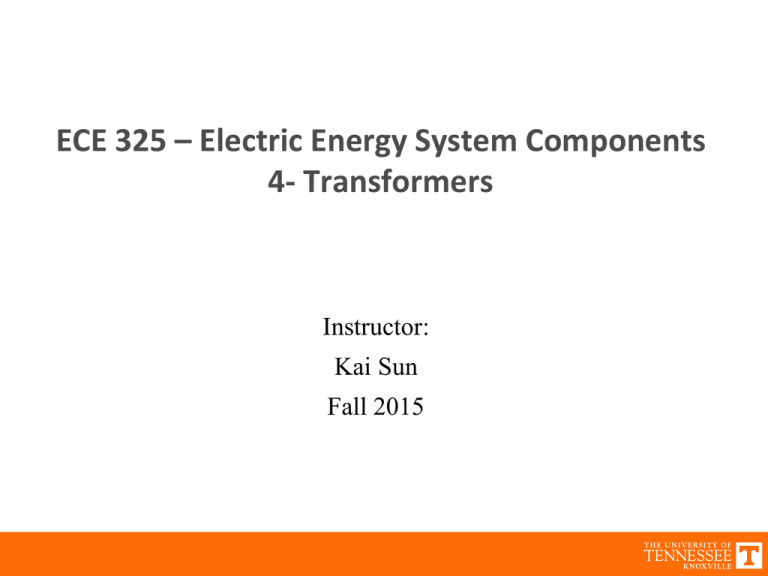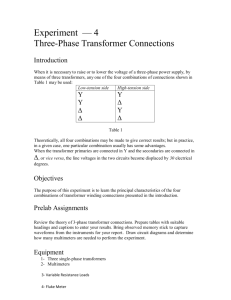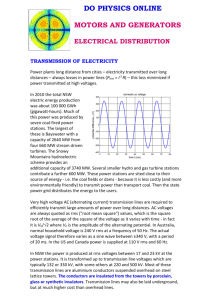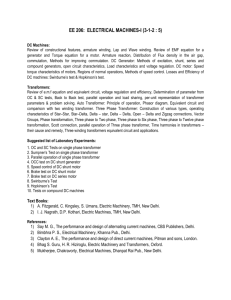ECE 325 – Electric Energy System Components 4- Transformers Instructor: Kai Sun
advertisement

ECE 325 – Electric Energy System Components 4- Transformers Instructor: Kai Sun Fall 2015 1 Content • Ideal Transformer (Ch. 9) • Practical Transformers (Ch. 10) • Special Transformers (Ch. 11) • Three-Phase Transformers (Ch. 12) 2 Power Transformer • Ideal transformers – Winding resistance is negligible – No leakage flux – Permeability of the core is infinite (zero magnetizing current Ip is needed to produce flux) – No core loss • Real transformers: – Windings have resistance – Windings do not link the same flux (having leakage flux) – Permeability of the core is finite – Have core losses (hysteresis losses and eddy current losses due to time varying flux) 3 Ideal Transformer • Primary winding (assuming sinusoidal flux): Because there is no flux leakage, 1=2=m (mutual flux) I1 I2 E1 m max cos t d N1 max sin t dt E1max cos t 90 eg e1 N1 E1max 2 fN1 max 6.28 fN1 max 2 4.44 fN1 max • Secondary winding: Because there is no flux leakage d e2 N 2 m E2max cos t 90 E2max dt 2 fN 2 max 2 4.44 fN 2 max • Voltage/turns ratio Eg E1 4.44 fN1 max 90 E2 4.44 fN 2 max 90 a=E1/E2=N1/N2 4 No-load and Load Conditions I1 • Under no-load conditions, because of infinitely permeable core, no magnetizing current is required to produce flux m. There are I2 E1 I1=I2=0 • Under load conditions (I10, I20,) because of the infinitely permeable core, there is an exact mmf balance E2 Eg, E1 I1 F1=I1N1=I2N2=F2 E1 I 2 N1 a E2 I1 N 2 E2 Eg, E1 • Phasor diagram: – Assume power factor cos I1 I2 5 Circuit Symbol for an Ideal Transformer E1 aE2 I1 I2 a Eab aEcd I1 I2 a 6 Impedance Ratio E2 Z I2 E1 aE2 I1 I 2 / a E1 aE2 ZX a2Z I1 I 2 / a • Impedance transformation – The impedance seen by the source (primary side) is a2 times the real impedance (secondary side) – Thus, an ideal transformer has the amazing ability to increase or decrease the value of an impedance 7 Shifting Impedances (SP) Zp a2 Zs Ep a Es Ip 1/a Is 2 3 4 1 8 Shifting Impedances (PS) Zp 1/a2 Zs Ep 1/a Es Ip a Is 1 2 aI1 9 Examples 9-4&9-5 10 Considering an imperfect core If Im Im If • Pm+jQm and Io are the complex power and current outputs of source Eg under no-loading conditions. Pm is the iron loss • Rm is a resistance causing the iron loss and resulting heat Rm=E12/Pm If=E1/Rm • Xm is the magnetizing reactance that measures permeability of the core. A smaller Xm means lower permeability and needs a higher magnetizing current Im (i.e. bigger reactive power Qm) to set up mutual flux m Xm=E12/Qm Im=E1/jXm 11 Considering loose coupling and resistances of windings f1 f2 E1 =4.44fN1m E2 =4.44fN2m Ef1 =4.44fN1f1 Ef2 =4.44fN2f2 E1+Ef1=Ep=Eg E2+Ef2=Es • Define winding leakage reactances Xf1=Ef1/I1 Xf2=Ef2/I2 • Add winding resistances R1 and R2 in series with Xf1 and Xf2, respectively f1 f2 Ef1 Ef2 12 Equivalent Circuit of a Practical Transformer • No-load conditions – I1=I2=0 – Ignore R1, Xf1, R2 and Xf2 – EpE1=aE2=aEs • 10%-100% load conditions – Ip>>Io, – Ignore Io 13 Simplified Equivalent Circuits • No-load conditions – Ignoring winding leakage fluxes and losses • 10%-100% load conditions – Ignoring core reluctance and losses 14 Equivalent Circuits Referred to One Side a2 /a a2 a a /a2 a2 /a2 aIo /a Xm/a2 Rm/a2 15 Simplified Equivalent Circuits Referred to One Side • Under load conditions a Zp N1 N2 Rp j Xp R1 a 2 R2 j ( X f 1 a 2 X f 2 ) 16 Voltage Regulation • With the primary voltage held constant at its rated value, the voltage regulation is % change of the secondary voltage from no-load to full load (rated) ENL EFL Voltage Regulation = 100 EFL ENL: secondary voltage at no-load EFL: secondary voltage at full-load • The voltage regulation depends on the power factor of the load on the secondary side – If the load is capacitive, the full-load voltage may exceed the no-load voltage, in which case the voltage regulation becomes negative 17 Measuring Transformer Impedances • Open-circuit (no-load) test – Neglect R1, Xf1, R2, Xf2 – Measure Pm (core loss), |Ep|, |Io| and |Es| Rm | E p |2 Pm | I f | E1=aEs | Ep | Rm | I m | | I o |2 | I f |2 Xm | Ep | | Im | N1 | E p | a N 2 | Es | 18 • Short-circuit test – Apply a low voltage ESC to the primary side to create ISC less than the nominal value to prevent overheating and rapid change in winding resistance – Neglect Rm and Xm due to low core flux | Esc | | Z p | | I sc | Psc Rp | I sc |2 X p | Z p |2 R p2 19 Construction of a power transformer • Core: made of iron for high permeability; laminated and high resistive to reduce iron losses • Windings: the primary and secondary coils are wound closely on top of each other with careful insulation for tight coupling; the HV winding has more turns but uses a smaller size of conductor, so copper/aluminum of two windings are about the same 20 Standard terminal markings and polarity tests • High-Voltage winding (H1&H2) and Low-Voltage winding (X1& X2) EH1,H2/EX1,X2=EH/EX=NH/NX • Polarity test: 1. 2. 3. 4. Connect HV winding to a low voltage source Eg Connect a jumper J between any two adjacent HV and LV terminals Connect two voltmeters to as shown in Figure 10.11 The polarity is additive if |Ex|>|Ep| or, otherwise, is subtractive. 21 The Per-Unit System • Quantity in Per-Unit = Actual quantity / Base or nominal value of quantity • Why per-unit notations? Choose 20kV, 345KV and 138kV as base voltages – Neglecting different voltage levels of transformers, lines and generators – Powers, voltages, currents and impedances are expressed as decimal fractions of respective base quantities (Source: EPRI Dynamic Tutorial) 22 • Four base quantities are required to completely define a per-unit system I E Z S I E Z S pu pu pu pu In Zn En Sn • We need to select two independent base quantities of the four and calculate the other two, e.g. selecting Sn and En E E Zn n n In Sn Sn In En 2 • For a transformer: – Usually, Sn, Epn, Esn and the total impedance Zp (in p.u. or %) referred to the primary side are given. I np Sn Enp Z np Enp I np I ns Enp Sn Sn Ens a 2 () Z ns Np Ns Enp Ens E E ns ns I ns Sn 2 () Z p () Z p (p.u.) Z np 23 Examples 10-5, 10-6, 10-7, 10-8 & 10-10 24 Autotransformer • A conventional two-winding transformer can be changed to an autotransformer by connecting its two coils in series (note: 4 combinations). • The connection may use a sliding contact to providing variable output voltage. (Source: EPRI Power System Dynamic Tutorial) 20MVA (115/69kV) McGraw-Edison Substation Auto-Transformer (Y-Y) (Source: http://www.tucsontransformer.com) 25 N1 • The primary and secondary windings have a common terminal A, and hence are not isolated from each other E2/E1=ECA/EBA=N2/N1 (There is always N1>N2) I1N1=I2N2 I1(N1-N2)=(I2-I1)N2 E1I1=E2I2 • An autotransformer has a smaller size (or equivalently, a higher kVA rating for the same size) but loses insulation between primary and secondary windings 26 Conventional transformer connected as an autotransformer (Example 11-2) • Reconnect the transformer to obtain – 600V / 480V – 600V / 720V – 120V / 480V – 120V / 720V • I1=15000/600=25A • I2=15000/120=125A When a transformer connects a source (on the primary side) with a load (on the secondary side), it is the load (current flows into terminal +) of the primary circuit and is the source (current flows out of terminal +) of the secondary circuit, so two winding currents (I1 and I2) have opposite directions. 27 I2=125A X2 I2-I1=100A 600V 120V H2 + 120V X1 H1 - 600V X1 H1 - H2 + X2 + 480V I1=25A - |Si|=600100=60kVA |So|=480125=60kVA I2=125A I2+I1=150A + 600V X1 X2 H1 + + H2 120V - I2-I1=100A 720V + 120V I1=25A H2 - I1=25A |Si|=600150=90kVA |So|=720125=90kVA - - - - 600V H1 X1 + I2=125A 480V + X2 |Si|=120100=12kVA |So|=48025 =12kVA The maximum apparent power |Smax|=max(|E1|,|E2|)(|I1|+|I2|)= (|E1|+|E2|) max(|I1|, |I2|) 28 Voltage Transformers and Current Transformers • Voltage transformers (VTs), also called potential transformers (PTs), are installed on HV lines to measure line-to-neutral voltage • Current transformers (CTs) are used to measure or monitor the current in a line for system measurement and protection 7kVA 80.5kV 50/60Hz PT 5kVA, 100A/5A 60Hz CT 29 Three-Phase Transformers • A bank of three single-phase transformers connected in Y or configurations – Four possible combinations: Y-Y, △-△, Y-△ and △-Y – Y: lower insulation costs, with neutral for grounding, 3rd harmonics – △: more insulation costs, no neutral, no 3rd harmonics 30 3rd harmonics problem with three-phase transformers • A △ configuration provides a closed path for 3rd harmonics, or in other words, all triple harmonics are trapped in the △ loop. Distorted waveform Fundamental 3rd harmonic , 3, 5, 7 9 , 5, 7 , 3, 5, 7 9 3 9 , 5, 7 , 3, 5, 7, 9 , 5, 7 31 Three-phase transformers: - connection • Each transformer, considered alone, acts as if it were placed in a single-phase circuit. • Because EH1H2 and EX1X2 are in phase for each single transformer, line voltages EAB with E12, EBC with E23, and ECA with E31 are in phase. • A balanced three-phase load produces balanced line currents in line 1-2-3 and lines A-B-C • The power rating is 3x of a single transformer. • One transformer may be absent (i.e. open-delta connection) under maintenance or emergency conditions 3 Ip 3 Is 32 Three-phase transformers: -Y (or Y-) connection • X2 terminals of 3 secondary windings are connected to a common neutral N. • Because EH1H2 and EX1X2 are in phase for each single transformer, EAB with E1N, EBC with E2N, and ECA with E3N are in phase. • There is a 30o phase shift between the line voltages of the incoming (EAB) and outgoing (E12) lines • △-Y is commonly used for voltage step-up transformers while Y-△ is commonly used for voltage step-down transformers 3 Ip E3N EN2 30o E1N E2N 33 Three-phase transformers: Y-Y connection • No phase shift between the incoming and outgoing line voltages • Without a configuration to trap the 3rd harmonic, it has seriously distorted voltages due to the 3rd harmonics. • Two solutions: – Ground the neutrals of the primary winding and the source – Provide each transformer with a tertiary winding, and connect 3 tertiary windings in delta 34 Phase-shifting Principle • A 3-phase system can easily shift the phase angle of a voltage to create 2-, 6-, and 12-phase systems used in power electronic converters and controllers • Phase shifting (performed by phase-shifting transformers) is also used in power flow control over long transmission lines 35 Phase-shifting transformers • A special type of 3-phase autotransformer that shits the phase angle between the incoming and outgoing lines without changing the voltage ratio. • Twist all incoming line voltages by angle (0~20o) without changing their magnitudes 36 Calculations involving 3-phase transformers • For any 3-phase transformer bank, assume that the primary and secondary windings are both connected in Y configuration (if not, transform it to Y by |ZY|=|Z|/3) • Consider only one transformer (single phase) of the assumed Y-Y transformer bank – Its primary and secondary voltages are both the line-to-neutral voltages of the incoming and outgoing lines – Its nominal power rating and load are 1/3 of the 3-phase transformer bank 37 Examples 12-1, 12-2, 12-3, 12-6 & 12-7 38 Homework Assignment #3 • Read Chapters 9&10 • Questions: – Prove the polarity test on slide #21 – 9-4, 9-5, 9-6, 9-7, 10-19, 10-28, 10-29, 10-30, 10-31 • Due date: – hand in your solution in the class on 10/5 (Mon) or – to Denis at MK 205 or by email (dosipov@vols.utk.edu) before the end of 10/5 39





